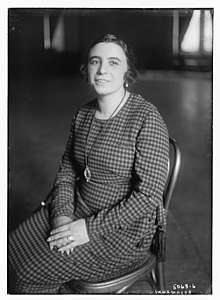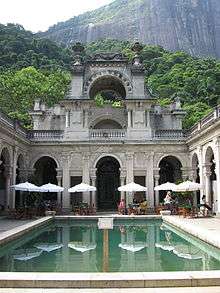Gabriella Besanzoni
Gabriella Besanzoni (September 20, 1888 – July 8, 1962) was an Italian opera singer (mezzo-soprano and contralto).

Early life
Gabriella Besanzoni was born in Rome and studied at the Accademia Nazionale di Santa Cecilia.[1]
Career
Besanzoni had her debut at Viterbo in 1911. From 1918 she was a star of the Teatro Colón of Buenos Aires, with regular appearances in other South American cities, especially Rio de Janeiro. Her debut in the United States happened in 1919, when she sang Amneris in Aida with Claudia Muzio, Giovanni Martinelli, and Renato Zanelli. That same season, she starred with Enrico Caruso in productions of Samson et Dalila and La Forza del Destino at the Metropolitan Opera.[2] The pair were appearing together in Aida in Havana in 1920 when a bomb exploded in the auditorium during the second act of the final performance.[1]
She left the Teatro Colón in 1935, and held her farewell concert in Rome in 1939, singing Carmen at the Baths of Caracalla. She made several recordings for Victor,[3] and appeared in one Italian silent film, Stefania (1916). She taught young singers in Brazil during her marriage, and also taught voice in Rome in her later years.
Tenor Giacomo Lauri Volpi mentioned her in his Voci parallele as one of the only three real contraltos he had chanced to meet throughout his career (the others being Margaret Matzenauer and Matilde Blanco Sadun).[4]
Personal life

Gabriella Besanzoni and pianist Arthur Rubinstein were romantically involved in 1918 when both were working in Madrid, Buenos Aires, and New York.[5] Besanzoni married Brazilian industrialist Henrique Lage in 1925. The couple lived in Rio de Janeiro; their grand home and gardens are now known as Parque Lage, a public park. Besanzoni was widowed in 1941; she married again in 1956, and she died in Italy in 1962, aged 74 years.[6] She was buried in one of her Carmen costumes.[7]
References
- Richard P. Connell, Liner Notes, Jose Mojica - Tenor; Gabriella Besanzoni - Alto, ArkivMusic.
- "Samson and Dalila" Musical America (December 20, 1919): 4.
- "Gabriella Besanzoni (vocalist: contralto)" Discography of American Historical Recordings (UC Santa Barbara Library).
- Cited (in Italian) in Celletti, Rodolfo, La grana della voce. Opere, direttori e cantanti (2nd edition), Rome, Baldini & Castoldi, 2000, p. 245, ISBN 88-80-89-781-0
- Harvey Sachs, Rubinstein: A Life (Grove Press 1995): 170-172. ISBN 9780802115799
- "Gabriella Besanzoni" The News-Messenger (July 10, 1962): 2. via Newspapers.com

- Victoria Etnier Villamil, "O ma Carmen": Bizet's Fateful Gypsy in Portrayals from 1875 to the Present (McFarland 2017): 97. ISBN 9781476663241
External links
| Wikimedia Commons has media related to Gabriella Besanzoni. |
- Gabriella Besanzoni on IMDb
- Gabriella Besanzoni's page on CantabileSubito.de, with biographical notes, sound clips, and many photographs.